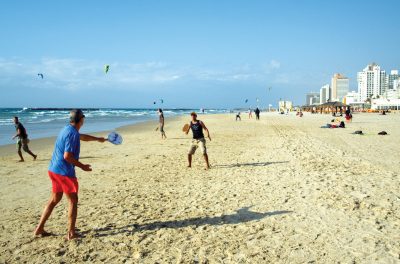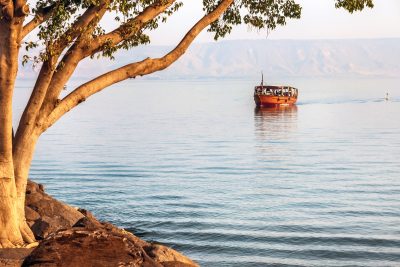×


We have detected your country as:
Please click here to go to the USA website or select another country from the dropdown list.
by: Ilse Strauss, News Bureau Chief
Every tourist shop in the Promised Land stocks a range of brightly colored t-shirts proclaiming that the wearer of the particular garment has dipped a toe in the four “seas” of Israel.
The claim is a bit of an overstatement, really. Only two of Israel’s famous waterbodies—the Red Sea and the Mediterranean Sea—meet the criteria to qualify as bona fide seas. The third—the Dead Sea—presents a bit of a quandary, with its official status depending on which expert you consult. Then there’s the fourth, final and arguably most famous waterbody—the Sea of Galilee—which, contrary to what its name implies, is not a sea at all.
Still, it’s a singular treat to explore the waterbodies that Scripture introduces as Israeli’s four “seas.”
 The word “Mediterranean” conjures up mental images of idyllic holidays on the French Rivera or the Greek Isles. Yet with nearly 124 miles (200 km.) of Mediterranean coastline, Israel boasts some of the most picturesque beaches in the world. From the northernmost tip near Rosh HaNikra spanning south to Ashkelon, there are nearly 100 pristine beaches to choose from.
The word “Mediterranean” conjures up mental images of idyllic holidays on the French Rivera or the Greek Isles. Yet with nearly 124 miles (200 km.) of Mediterranean coastline, Israel boasts some of the most picturesque beaches in the world. From the northernmost tip near Rosh HaNikra spanning south to Ashkelon, there are nearly 100 pristine beaches to choose from.
Many spots also come with a backstory of biblical events that played out where children now frolic in the surf and parents play matkot (a beach paddle game so popular that it’s called Israel’s national sport). The Bible calls the Mediterranean Sea the Great Sea, the Western Sea or simply “the sea.” Its shore witnessed Jonah’s ill-fated bid to escape God’s call, served as the stomping ground for the Philistines and in Christianity, saw Peter baptize Cornelius and Paul await passage to Rome.
The Mediterranean Sea also features as a boundary marker in God’s covenantal promise to Abraham’s posterity. In Deuteronomy 11:24, Moses reminds the Children of Israel that everywhere their soles tread will be theirs, “from…the River Euphrates, even to the Western Sea” (see also Num. 34:6).
 Bab-el-Mandeb or the Gate of Grief—a narrow strait between the Arabian Peninsula and the Horn of Africa—connects the Red Sea to the Indian Ocean. The aquatic lifeline makes for a paltry exchange of water, which, combined with the low precipitation and high temperatures, turns the Red Sea into a unique habitat. The result? The 9-mile (14-km.) swathe of coastline in Eilat, Israel’s southernmost city, serves as the gateway to an underwater paradise with 300 species of coral and 2,100 species of fish, many unique to the Red Sea. Add to that a laid-back atmosphere, the red Negev mountains rising on the horizon and clear waters lapping pebbled beaches, and you have the perfect spot to get away from it all.
Bab-el-Mandeb or the Gate of Grief—a narrow strait between the Arabian Peninsula and the Horn of Africa—connects the Red Sea to the Indian Ocean. The aquatic lifeline makes for a paltry exchange of water, which, combined with the low precipitation and high temperatures, turns the Red Sea into a unique habitat. The result? The 9-mile (14-km.) swathe of coastline in Eilat, Israel’s southernmost city, serves as the gateway to an underwater paradise with 300 species of coral and 2,100 species of fish, many unique to the Red Sea. Add to that a laid-back atmosphere, the red Negev mountains rising on the horizon and clear waters lapping pebbled beaches, and you have the perfect spot to get away from it all.
Yet the Red Sea doesn’t owe its fame to snorkelers and scuba divers. God carved it into the pages of history when He parted the waters for the Israelites to pass through—while their Egyptian pursuers perished. Aside from the famous crossing, God also identified this waterbody as another stake marking the Promised Land’s boundary, “And I will set your bounds from the Red Sea to the sea, Philistia” (Exod. 23:31a).
The Dead Sea’s shores mark the lowest point on earth, while the high salt content—nearly 10 times brinier than the ocean—qualifies it as the world’s fourth saltiest waterbody. This high salinity means dense water that keeps bathers buoyant and turns swimming into floating. Packed with 26 minerals, the briny waters are also renowned for its medicinal value, which beckons thousands to the Dead Sea shores for a beautifying, therapeutic mud bath.
The hypersalinity makes for a harsh habitat where life cannot flourish, hence the name. But it’s this barrenly beautiful landscape, dotted with stark salt formations against an azure expanse, that imbues the Dead Sea with an otherworldly allure.
The Bible calls this waterbody the Salt Sea, the Sea of the Arabah and the Eastern Sea. It features in biblical accounts dating back to the time of Abraham and stands as another beacon for the border of the Promised Land (Num. 34:3, 12; Deut. 3:17).
Yet the Dead Sea’s future is arguably more significant than its past or present. Both Ezekiel (47:18) and Zechariah (14:8) prophesied about a time when the briny Dead Sea will gush with sweet, fresh water teaming with life.
 First-century historian Josephus Flavius extoled the beauty of the Galilee as the “ambition of Nature.” It’s easy to see why. The pastoral lake lies tucked into hazy heights. Sleepy villages, a sprawling city and bright mango groves spill side by side like strips of carpet from the slopes to trickle onto pebbled shores, while replicas of biblical fishing boats ferry tourists back and forth through the lapping waves. The Sea of Galilee exudes a serenity that you want to tuck into your heart and carry back into the chaos of life.
First-century historian Josephus Flavius extoled the beauty of the Galilee as the “ambition of Nature.” It’s easy to see why. The pastoral lake lies tucked into hazy heights. Sleepy villages, a sprawling city and bright mango groves spill side by side like strips of carpet from the slopes to trickle onto pebbled shores, while replicas of biblical fishing boats ferry tourists back and forth through the lapping waves. The Sea of Galilee exudes a serenity that you want to tuck into your heart and carry back into the chaos of life.
Israelis call the Sea of Galilee the Kinneret, supposedly from the Hebrew word kinnor (harp/lyre) for the lake’s harp-like shape. Fed and drained by the Jordan River, it’s Israel’s largest freshwater source, the lowest freshwater lake on Earth and the second-lowest lake in the world after the Dead Sea.
The Tanakh (Gen.–Mal.) calls it the Sea of Chinnereth (Num. 34:11; Deut. 3:17; Josh. 12:3, 13:27, 19:35), identifying the area as the heritage of Naphtali, Zebulun and Issachar. And Isaiah prophesied that the Messiah would hail from this region (9:1–2, 6). In Christianity, the Sea of Galilee plays a pivotal role in the Gospels, with the shores and even the waves setting the stage for Jesus’ (Yeshua’s) miracles, encounters and preaching.
Today, a number of churches dot the shoreline, drawing scores of Christian pilgrims every year. And in the spring and summer, locals flock to the 35-mile (56-km) lakeshore to enjoying the sunshine, splash in the waves or try their hand at watersports.
With all the aquatic fun within easy reach, why not set aside time during your next trip to Israel to earn one of those brightly colored t-shirts to proclaim proudly that you’ve sailed the Sea of Galilee, swam in the Mediterranean Sea, floated in the Dead Sea and snorkeled in the Red Sea?
Photo Credit: Click on photo for photo credit
Photo License: Players on the beach in Tel Aviv
All logos and trademarks in this site are property of their respective owner. All other materials are property of Bridges for Peace. Copyright © 2024.
Website Site Design by J-Town Internet Services Ltd. - Based in Jerusalem and Serving the World.